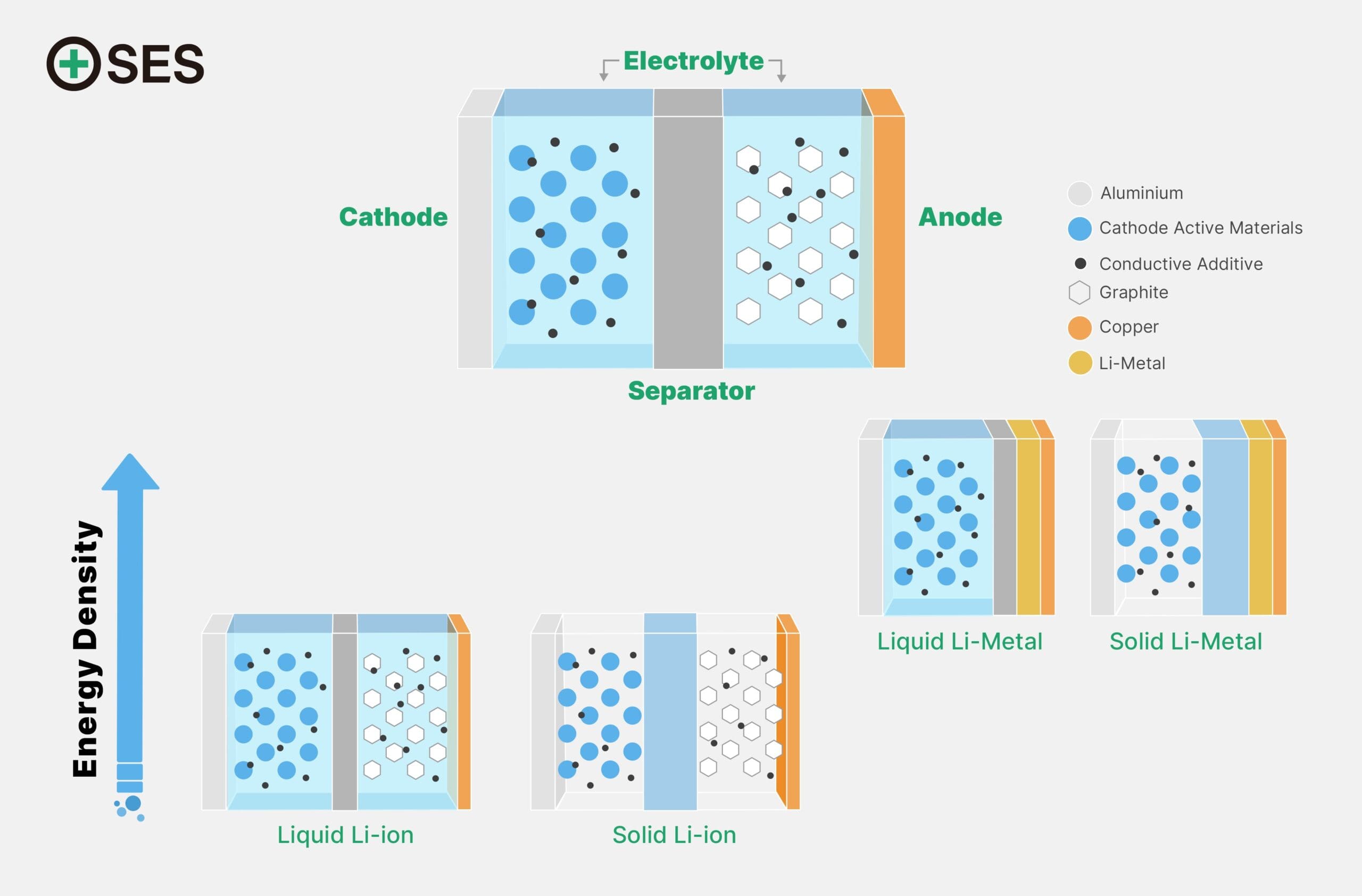
February 8, 2024 Debunking the Myth of Solid-State Batteries
No one should read this article.
No one should care about this discussion.
“Solid-state” batteries are often perceived as the holy grail, the future of automotive batteries. But exactly what are they? And why should anyone care if the battery inside the car is solid or liquid? The goal of this article is to clarify certain definitions and elucidate the pros and cons of solid and liquid, and why this discussion really does not matter.
Figure above shows a battery with its components (for simplicity, we use a generic illustration of a lithium battery as an example, this could be a Li-ion or Li-Metal battery. It has 4 main components: cathode, separator, electrolyte, and anode.
Some of the common materials for the 4 components include:
1. cathode: lithium cobalt oxide (LCO), lithium nickel manganese cobalt oxide (NMC), lithium iron phosphate (LFP)
2. separator: polyethylene (PE), polypropylene (PP)
3. electrolyte (solid and liquid)
solid:
- polymer: polyethylene (PEO)
- inorganic oxides: garnet, LLZO, LiSICON
- sulfides: LGPS
- halides: Li6PSCl
liquid:
- salts: lithium hexagon phosphate (LiPF6), lithium bis(trifluoromethanesulfonyl)imide (LiTFSI), lithium bis(fluorosulfonyl)imide (LiFSI)
- solvents: ethylene carbonate (EC), dimethyl carbonate (DMC), ethylmethyl carbonate (EMC), dimethoxyethane (DME), ionic liquids
- additives: vinyl carbonate (VC), monofluoroethylene carbonate (FEC)
- formulation type: low concentration, high concentration, ionic liquids
4. anode:
- Li-ion: graphite, silicon, graphite-silicon composite
- Li-Metal: lithium metal or lithium-based alloy
Note that solid or liquid only refers to the state of the electrolyte. A battery could be almost any combination of the 4 components, for example “LFP solid Li-ion” or “LFP liquid Li-Metal” or “NMC liquid Li-ion” or “NMC solid Li-Metal”, etc. All lithium batteries can be divided into 4 categories: liquid Li-ion, solid Li-ion, liquid Li-Metal, and solid Li-Metal.
So when someone says “solid-state” battery, exactly which battery are they referring to? Figure above shows that solid or liquid does not impact energy density. It is actually Li-Metal or Li-ion that determines energy density. For example, solid Li-ion has no energy density improvement over liquid Li-ion (for the same cathode), liquid Li-Metal has significant energy density improvement over liquid and solid Li-ion (for the same cathode).
There is great stereotype that solid is safer than liquid, especially when it comes to pairing with Li-Metal. That might be true in the 1990s. But there has been great progress in liquid electrolyte recently with high concentration solvent-in-salt, ionic liquids and other liquid approaches that have dramatically improved the safety characteristics of Li-Metal. Also the safety of Li-Metal or Li-ion doesn’t just depend on solid or liquid electrolyte, it also greatly depends on the choice of cathode, cell capacity, engineering design and many other factors. Furthermore, solid Li-ion and Li-Metal batteries have great manufacturing and scalability challenges that have not been solved for many years, and solid-state batteries remain expensive, limited to small capacity cells, and they too, sometimes catch on fire.
We at SES used to spend a lot of time on the word “solid”. When we started in 2012, we were called SolidEnergy because we worked on solid Li-Metal. But then we pivoted to liquid Li-Metal in 2015 and changed our name officially from SolidEnergy to SES in 2021. We stopped caring about solid or liquid. One of our automotive OEMs said “why does it matter? who cares about solid or liquid? our users care about cost, range, fast charge, safety, and many other features, but I bet you they won’t care if there’s a dry brick or wet towel inside the battery.”
A battery is a complex system that includes material chemistry, cell engineering, health monitoring algorithm, etc. and needs to be optimized for energy density, cycle life, cost, fast charge, power density, safety, etc. Focusing on solid or liquid of the electrolyte sets an unnecessary bias that limits our ability to innovate. The true holy grail should be Li-Metal since that gives us impressive energy density gain, not solid-state. There is nothing fundamentally superior about solid, and at the same time there is nothing fundamentally flawed about liquid. It is inappropriate for the industry to discriminate a battery based on the phase of its electrolyte being solid or liquid.
Unfortunately, you didn’t listen to me, and you read through this article. As I said in the beginning, no one should care about this discussion. Next time, instead of asking if there is a solid or liquid battery inside the car, ask if the car comes in purple.
Share this post
Author
-

Dr. Qichao Hu is the founder and CEO of SES AI (NYSE: SES), the Boston-based company pioneering the world’s lightest long-range Li-Metal battery and transparent EV battery supply chain. Dr. Hu has a BS in Physics from MIT and a PhD in Applied Physics from Harvard.
View all posts

